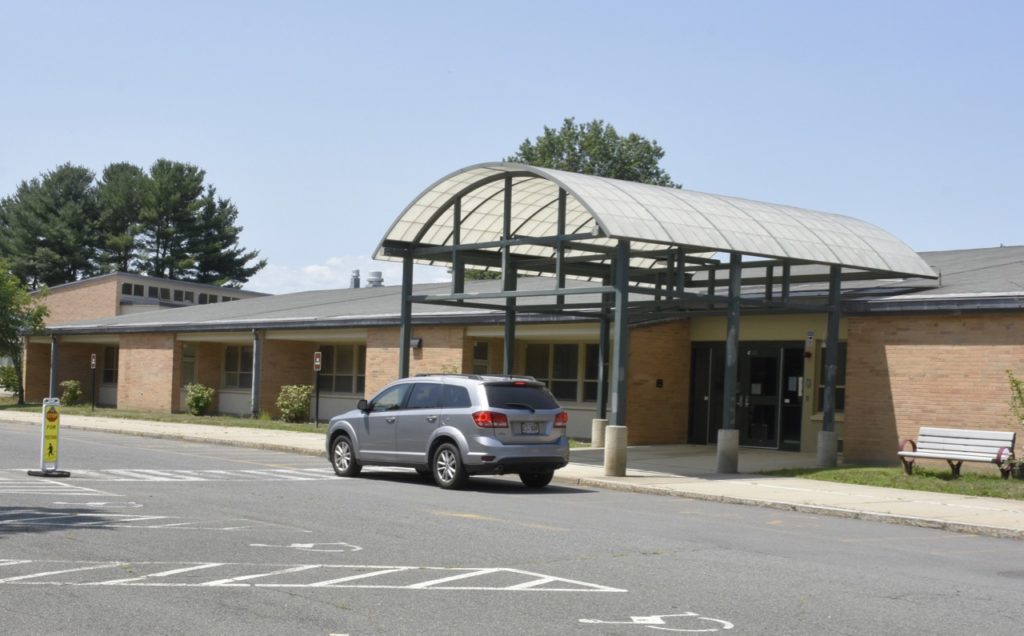Opinion: Don’t Ignore The Needs Of Crocker Farm

Crocker Farm School. Photo: Art Keene
In a few years time, Amherst will hopefully open the doors of a school building that will bring security, fossil-fuel-free energy efficiency, and current educational infrastructural standards to 60% percent of its elementary students and educators. As we move ahead to meet these goals, we must also make concrete plans and commitments to adequately meet the needs of the other 40% of students and educators.
The current school building project will most likely replace both Fort River and Wildwood schools with a single building that will accommodate 575 students in kindergarten through fifth grade. The MSBA has projected that town-wide elementary enrollment will stabilize and then rebound to levels last seen in 2014, with an average of 950 students in grades K-5 through 2030. This means that Crocker Farm, the other elementary school in town, will need to accommodate 375 K-5 students. If the preschool (that occupies about 20% of the building’s academic spaces with an enrollment of about 60 students) remains at Crocker Farm in a future two-school scenario, the total enrollment at the school will be at an historic high. In recent years, with a lower enrollment, the school has been described by district officials as “bursting at the seams.”
Over the past several years, attention has focused on the needs of the Fort River and Wildwood school buildings, with their well-documented infrastructure challenges. Crocker Farm, in contrast, has been held up as the well-functioning, more desirable school building. While it does not suffer from the problematic open-classroom design that has plagued its counterparts since their inception, Crocker Farm has many problems of its own, which have not been widely discussed or adequately addressed by the District and Town.
Many of Crocker Farm’s structural problems will sound familiar to those following the school building story:
Leaking roof? Check.
Heating and ventilation system at the end of its useful life? Check.
Inconsistent temperature and humidity control? Check
Non-compliance with accessibility standards? Check.
Lack of break-out spaces for individual/small-group learning? Check.
Inadequate security? Check.
Inadequate space for special needs services? Check.
Playing fields with poor drainage, resulting in standing water after rains? Check.
In addition, the gymnasium is less than half the size recommended by the MSBA (not even half a basketball court) and is surrounded by classrooms. This location of the gym represents a security vulnerability and prevents the use of the space as a community resource. Finally, like the Amherst Regional Middle and High Schools, a school-wide indoor air quality evaluation has not been performed for at least 20 years. (Recent testing measured only Air Changes per Hour – a ventilation metric used to assess potential for airborne virus transmission.)
A comprehensive study completed last year looked at Crocker Farm’s current and future needs. The findings showed the need for $9 million in near-term repairs, with total costs of up to $20 million to achieve long-term goals of a secure and equitable educational experience on par with that expected in the new elementary building. This was undoubtedly unwelcome news to Town leadership who already have four major capital projects on their radar: the Fort River/Wildwood replacement; renovation/reconstruction of the Jones Library; a new south fire station, and replacement of the public works building. But the needs of Crocker Farm are real and pressing, and meeting them is not only integral to resolving the Gordian knot of the elementary school buildings but would also provide space that all town residents could use for meetings, social events, athletics, and other programming. And yet, despite receiving this information last summer, a comprehensive approach to Crocker Farm is still not on the list of needed major capital projects.
Many Town leaders have refused to publicly rank by priority the four major capital projects, let alone the many other capital needs in Town. But funds are limited, and when money is spent on one project, it means others will have less or none at all. In addition, when the budgets for project designs are not capped from the beginning or considered as part of a Town-wide infrastructure plan, their scope and budget have a tendency to balloon rather than remain constrained by fiscal realities. Grants have been sought that require a significant commitment of Town funds, before overall priorities have been established, which ends up creating defacto priorities that may not make sense or which may not actually be widely supported.
Amherst prides itself in placing equity as an important value in its decisions and policies. Including Crocker Farm in all deliberations about capital projects, and committing the funding required to bring Crocker Farm to parity with the new elementary school, is both a fiscal and moral imperative.

Thank you for your detailed reporting on this issue. It is important that in Council and public discussions on upcoming capital needs that all the major capital projects, included the wastewater treatment plant and Crocker Farm, be included and considered on the short list, not just the Big 4. Those needs are also pressing and together those projects add up to 10s of millions of dollars.